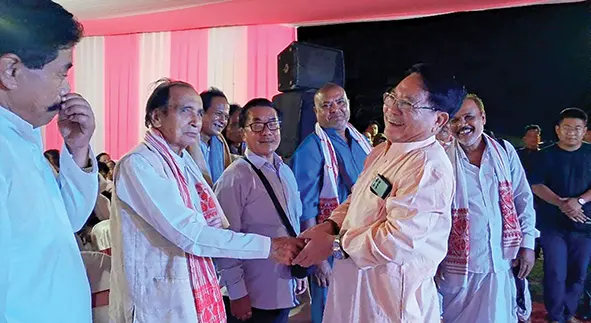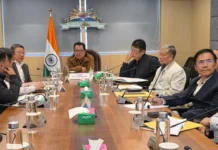KHONSA, 27 Oct: The 286th death anniversaries of Sri Ram Ata, the third satradhikar of Sri Sri Chaliha Bareghar Satra, and his disciple Narottam, the 18th-century Nocte chief of Namsang and Borduria, were observed with great reverence at Namsang village in Tirap district on Sunday.
Jointly organised by Sri Sri Chaliha Bareghar Satra and
the Namsang Youth Council, the celebration began with chanting of devotional hymns, led by Gojen Mahanta, satradhikar of Merbil Chaliha Bareghar Satra, followed by a spiritual discourse among disciples.
Around 500 people, including nearly 100 delegates from Pontuan, a Nocte village in Naharkatia, Assam, joined the celebration.
The main highlights of the evening were performance of ‘gayan-bayan’ and enactment of a ‘bhavna’ by a troupe of artists from Cahchani, Assam.
Narottam, originally known as Hote, was remembered for his remarkable spiritual transformation and his pivotal role in bridging Ahom and Nocte traditions. Known among the Ahoms as Latha Khunbao, Hote was initiated into Vaishnavism by Sri Ram Ata, who discerned a rare spiritual depth in the young chief. Upon initiation, Hote was bestowed the name ‘Nor-uttam’, meaning the noblest among men.
As divine symbols of blessing, Sri Ram Ata presented him with a pair of finely crafted silver bangles inlaid with gold and a traditional pair of broad bangles called ‘gam kharu’. These sacred gifts symbolised Hote’s spiritual rebirth and unwavering devotion to the Vaishnavite faith.
The initiation ceremony, steeped in reverence and symbolism, marked not only a moment of personal enlightenment but also a historical bridge between the Ahom and the Nocte communities.
In a recent communication with Nocte Digest, Professor Stephen Morey, noted linguist from La Trobe University, Australia, shared insights into the meaning of Hote’s Ahom title Latha Khunbao.
According to him, the prefix ‘La’ denotes son – as in Lachit (seventh son), Langi (second son), or Lasam (third son). However, he observed that the syllable ‘tha’ does not correspond to a numeral in the Ahom language, suggesting that it may have roots in the Nocte tongue. The term Khunbao, he added, combines khun (prince or king) and bao/bau (young man), possibly translating to ‘young prince’.
The annual commemoration at Namsang continues to serve as a bridge between faith, history, and cultural identity, honouring the shared spiritual heritage of the Ahoms and the Noctes.
The event was attended by Environment & Forests Minister Wangki Lowang, Deomali ADC Badonlum Tawsik, Namsang ZPM Wangphoon Lowang, WRD EE Tapi Tanya, chiefs, and GBs from neighbouring villages. (DIPRO)




